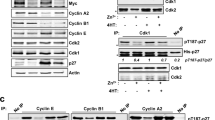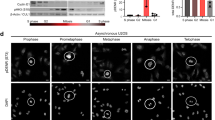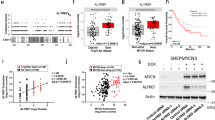Abstract
The c-Mos serine/threonine protein kinase is an essential component of cytostatic factor (CSF), which is required for metaphase II arrest of eggs in vertebrates. Previously, we showed that c-Mos residue Ser-16 is phosphorylated in the ts110 Mo-MuSV-encoded Gag-Mos fusion protein. Here we provide evidence that Mos is phosphorylated at Ser-16 in transfected COS-1 cells. To investigate the role of this phosphorylation, Ser-16 was substituted with alanine or glutamic acid in full-length v-Mos (an Env-Mos fusion protein that contains 31 additional amino acids at the amino terminus of c-Mos), its mouse c-Mos equivalent version (v-Mos residues 32-374, hereafter referred to as Mos), and mouse c-Mos. Constructs expressing mutant versions of Mos were transfected into COS-1 and NIH3T3 cells in a transient and stable manner, respectively. Synthesis and proteolysis of Mos were evaluated by pulse-chase analysis of 35S-methionine-labeled proteins. Our findings indicate that the S16A mutant of Mos was highly unstable. It accumulated to approximately 10% of the level of wild-type Mos or its S16E mutant. In addition, the S16A mutation but not the S16E mutation inhibited Mos interaction with a cellular protein, p35, suggesting that phosphorylation at Ser-16 may promote Mos interaction with p35. As expected from its destabilizing effect, the S16A mutation caused a dramatic decrease in the cellular transforming activity of Mos (determined by soft-agar colony-formation assay with the stably transfected NIH3T3 cells), which is known to correlate with its CSF function. Efficient ubiquitin-mediated proteolysis of c-Mos requires proline as the second residue from the amino-terminus. In contrast to Mos, neither the stability nor protein kinase activity of v-Mos (in which c-Mos residue Pro-2 becomes Pro-33) was affected by the S16A mutation. To provide further proof that, similar to c-Mos, the S16A mutant is recognized by the proteolysis system through Pro-2, we show that the effect of the S16A mutation is reversed by the Pro-2-Ala mutation. Thus, our results indicate that Ser-16 has an important role in the regulation of c-Mos and that phosphorylation at Ser-16 may inhibit proteolysis of c-Mos.
This is a preview of subscription content, access via your institution
Access options
Subscribe to this journal
Receive 50 print issues and online access
$259.00 per year
only $5.18 per issue
Buy this article
- Purchase on Springer Link
- Instant access to full article PDF
Prices may be subject to local taxes which are calculated during checkout







Similar content being viewed by others
References
Adra CN, Boer PH and McBurney MW. . 1987 Gene 60: 65–74.
Bai W, Singh B, Karshin WL, Shonk RA and Arlinghaus RB. . 1991 Oncogene 6: 1715–1723.
Boyle WJ, van der Geer P and Hunter T. . 1991 Methods Enzymol. 201: 110–149.
Chen M and Cooper JC. . 1995 Mol. Cell. Biol. 15: 4727–4734.
Freeman RS, Kanki JP, Ballantyne SM, Pickham KM and Donoghue DJ. . 1990 J. Cell Biol. 111: 533–541.
Hannink M and Donoghue DJ. . 1985 Proc. Natl. Acad. Sci. USA 82: 7894–7898.
Huang CYF and Ferrell Jr JE. . 1996 EMBO J. 15: 2169–2173.
Liu H, Vuyyuru VB, Pham CD, Yang Y and Singh B. . 1999 Oncogene 18: in press.
Liu J, Singh B, Wlodek D and Arlinghaus RB. . 1990 Oncogene 5: 171–178.
Matten WT, Copeland TD, Ahn NG and Vande Woude GF. . 1996 Dev. Biol. 179: 485–492.
Maxwell SA and Arlinghaus RB. . 1985 Virology 143: 321–333.
Nishizawa M, Okazaki K, Furuno N, Watanabe N and Sagata N. . 1992 EMBO J. 11: 2433–2446.
Nishizawa M, Furono N, Okazaki K, Tanaka H, Ogawa Y and Sagata N. . 1993 EMBO J. 12: 4021–4027.
Okazaki K, Furuno N, Watanabe N, Ikawa Y, Vande Woude GF and Sagata N. . 1991 Jpn. J. Cancer Res. 82: 250–253.
Pham CD, Arlinghaus RB, Zheng C-F, Guan K-L and Singh B. . 1995 Oncogene 10: 1683–1688.
Posada J, Yew N, Ahn NG, Vande Woude GF and Cooper JA. . 1993 Mol. Cell. Biol. 13: 2546–2553.
Roy LM, Haccard O, Izumi T, Larres BG, Lewellyn AL and Maller JL. . 1996 Oncogene 12: 2203–2211.
Sagata N, Watanabe N, Vande Woude GF and Ikawa Y. . 1989 Nature 342: 512–518.
Sambrook J, Fritsch EF and Maniatis T. . 1989 Molecular cloning. Cold Spring Harbour Laboratory Press. Cold Spring Harbor, N.Y.
Seth A and Vande Woude GF. . 1985 J. Virol. 56: 144–152.
Singh B, Al-Bagdadi F, Liu J and Arlinghaus RB. . 1990 Virology 178: 535–542.
Singh B and Arlinghaus RB. . 1997 Progress in Cell Cycle Research, Vol. 3. Meijer L, Guidet S and Philippe M. (eds.).. Plenum Press: New York, USA pp. 251–259.
Singh B, Hannink M, Donoghue DJ and Arlinghaus RB. . 1986 J. Virol. 60: 1148–1152.
Singh B, Herzog NK, Liu J and Arlinghaus RB. . 1988 Oncogene 3: 79–85.
van Beveren C, van Straaten F, Galleshaw JA and Verma IM. . 1981 Cell 27: 97–108.
Yaffe MB, Schutkowski M, Shen M, Zhou XZ, Stukenberg PT, Rahfeld J-U, Xu J, Kuang J, Kirschner MW, Fischer G, Cantley LC and Lu KP. . 1997 Science 278: 1957–1960.
Yang Y, Herrmann CH, Arlinghaus RB and Singh B. . 1996 Mol. Cell. Biol. 16: 800–809.
Yang Y, Pham CD, Vuyyuru VB, Liu H, Arlinghaus RB and Singh B. . 1998 J. Biol. Chem. 273: 15946–15953.
Yew N, Oskarsson M, Daar I, Blair DG and Vande Woude GF. . 1991 Mol. Cell. Biol. 11: 604–610.
Acknowledgements
We thank Ralph Arlinghaus for valuable suggestions and critical reading of the manuscript. We also thank Linda Kimbrough for typing and Lore Feldman for editing the manuscript. This work was supported by grants R01 CA45125 and CA16672 (core) from the National Institutes of Health.
Author information
Authors and Affiliations
Rights and permissions
About this article
Cite this article
Pham, C., Vuyyuru, V., Yang, Y. et al. Evidence for an important role of serine 16 and its phosphorylation in the stabilization of c-Mos. Oncogene 18, 4287–4294 (1999). https://doi.org/10.1038/sj.onc.1202804
Received:
Revised:
Accepted:
Published:
Issue Date:
DOI: https://doi.org/10.1038/sj.onc.1202804



